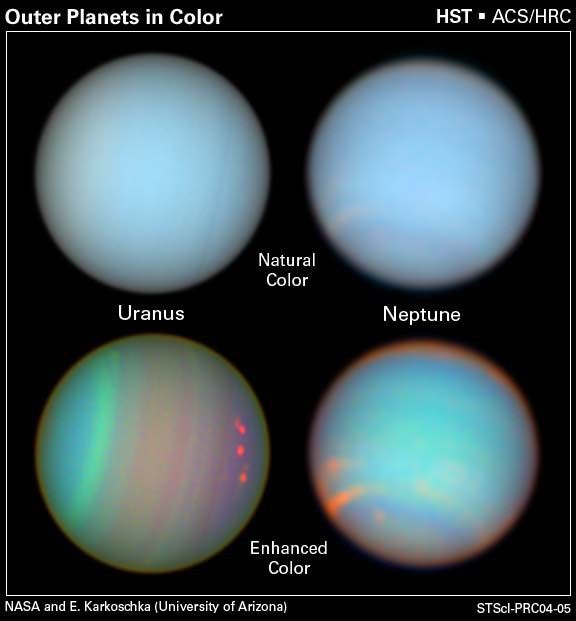1 min read
The Colorful Lives of the Outer Planets

Atmospheric features on Uranus and Neptune are revealed in images taken with the Space Telescope Imaging Spectrograph and the Advanced Camera for Surveys aboard NASA's Hubble Space Telescope. The observations were taken in August 2003.
The top row reveals Uranus and Neptune in natural colors, showing the planets as they would appear if we could see them through a telescope. The images are made of exposures taken with filters sensitive to red, green, and blue light. In the bottom images, astronomers used different color filters to detect features we can't see. The photographs demonstrate that, by using certain types of color filters, astronomers can extract more information about a celestial object than our eyes normally can see.
At first glance, the top row of images makes the planets appear like twins. But the bottom row reveals that Uranus and Neptune are two different worlds. Uranus's rotational axis, for example, is tilted almost 90 degrees to Neptune's axis. The south poles of Uranus and Neptune are at the left and bottom, respectively. Both are tilted slightly toward Earth. Uranus also displays more contrast between both hemispheres. This may be caused by its extreme seasons.
Both planets display a banding structure of clouds and hazes aligned parallel to the equator. Additionally, a few discrete cloud features appear bright orange or red. The color is due to methane absorption in the red part of the spectrum. Methane is third in abundance in the atmospheres of Uranus and Neptune after hydrogen and helium, which are both transparent. Colors in the bands correspond to variations in the altitude and thickness of hazes and clouds. The colors allow scientists to measure the altitudes of clouds from far away.
About the Object
- DistanceDistanceThe physical distance from Earth to the astronomical object. Distances within our solar system are usually measured in Astronomical Units (AU). Distances between stars are usually measured in light-years. Interstellar distances can also be measured in parsecs.The semi-major axis of Uranus's orbit about the sun is 19.18 Astronomical Units (A.U.) or roughly 2.9 billion km. The semi-major axis of Neptune's orbit about the Sun is 30.06 Astronomical Units (A.U.) or roughly 4.5 billion km.
- DimensionsDimensionsThe physical size of the object or the apparent angle it subtends on the sky.Uranus (without rings) has a diameter of roughly 32,000 miles (51,000 km) at the equator. Neptune has a diameter of roughly 30,800 miles (49,600 km) at the equator.
About the Data
- Data DescriptionData DescriptionProposal: A description of the observations, their scientific justification, and the links to the data available in the science archive.
Science Team: The astronomers who planned the observations and analyzed the data. "PI" refers to the Principal Investigator.The Uranus ACS/HRC data are from the HST proposal 9725: E. Karkoschka and M. Tomasko (U. AZ) The Uranus STIS/CCD data are from the HST proposal 9035: E. Karkoschka (U. AZ), M. Lemmon (Texas A&M), M. Tomasko (U. AZ) The Neptune STIS/CCD data are from the HST proposal 9330: E. Karkoschka (U. AZ), M. Lemmon (Texas A&M), M. Tomasko (U. AZ) Note: Uranus images within this press release were taken with ACS/HRC. They were color calibrated using STIS/CCD data of Uranus. Neptune images within this press release were taken with STIS/CCD. - InstrumentInstrumentThe science instrument used to produce the data.HST>ACS/HRC and HST> STIS/CCD (Uranus); HST> STIS/CCD (Neptune)
- Exposure DatesExposure DatesThe date(s) that the telescope made its observations and the total exposure time.August 19, 2002 and August 30, 2003 (Uranus); August 3, 2003 (Neptune)
- FiltersFiltersThe camera filters that were used in the science observations.Uranus ACS/HRC: F435W, F550M, F658N, F660N, F775W, F814W, F850LP, and F892N STIS/CCD: G430L and G750L Neptune STIS/CCD: G430L, G750L, CLEAR, and F28X50LP
- Object NameObject NameA name or catalog number that astronomers use to identify an astronomical object.Uranus, Neptune
- Object DescriptionObject DescriptionThe type of astronomical object.Planet
- Release DateJanuary 22, 2004
- Science ReleaseThe Colorful Lives of the Outer Planets
- CreditNASA and Erich Karkoschka, University of Arizona
Related Images & Videos

Rings and Moons Circling Uranus
This wider view of Uranus reveals the planet's faint rings and several of its satellites. The area outside Uranus was enhanced in brightness to reveal the faint rings and satellites. The outermost ring is brighter on the lower side, where it is wider. It is made of dust and...
Share
Details
Claire Andreoli
NASA’s Goddard Space Flight Center
Greenbelt, Maryland
claire.andreoli@nasa.gov


































